Economic, Energetic, and Environmental Performance of a Solar Powered Organic Rankine Cycle with Electric Energy Storage in Different Commercial Buildings
Abstract
1. Introduction
2. System Model
System Model
- (a)
- Pump (Process 1–2): The pump power is determined as:where is the hourly ideal work of the pump, is the hourly mass flow rate, , , and are the enthalpies for the pump inlet, the ideal pump exit, and the pump exit, respectively.
- (b)
- Solar Collector (Process 2–3): An isobaric process where heat is added to the working fluid before the turbine inlet. The flat plate solar collector replaces the evaporator in a traditional ORC system. The hourly mass flow rate for the working fluid can be found from the following equation:where is the hourly heat transfer rate from the solar collector and is the enthalpy of the working fluid as it leaves the solar collector. State 3 was assumed to be a saturated vapor at the high pressure of the working fluid which was 2 MPa.The hourly solar collector heat transfer rate is determined from the following equation:where is the hourly solar collector efficiency, is the hourly irradiation, and is the solar collector area.The solar collector efficiency is determined using the relationship:where is the y-intercept, is the slope, is the inlet temperature of the working fluid, and is the hourly ambient temperature which is taken from TMY3 (Typical Meteorological Year, version 3) weather data. The y-intercept and slope are terms provided by the manufacturer or third party certification; in the presented model the values for the y-intercept and slope are 0.760 and 6.125 W/(m2 °C), respectively [28]. The solar efficiency equation is the Hottel-Whillier-Bliss equation [29] where and correspond to:where is the collector heat removal factor, is the transmissivity of the glass cover plates, is the absorptivity of the absorber plate, and accounts for the losses due to conduction and radiation.The hourly irradiation values can be found from:where is the hourly total radiation, is the hourly direct normal irradiation, is the incidence angle, is the hourly diffuse horizontal irradiation, is the hourly surface tilt angle, is the hourly total horizontal irradiation, and is the ground reflectance. Hourly direct normal irradiation, diffuse horizontal irradiation, and total hourly irradiation can be found from the National Renewable Energy Laboratory TMY3 data [30]. The ground reflection value used is 0.2 which was found in literature [31]. The incidence angle and surface tilt angle are dependent of the solar collector configuration. In this study, the solar collectors were modeled as two-axis tracking solar collectors which allow for the absorption of the maximum solar irradiation. The incidence angle for a two-axis tracking system is zero. Having a two-axis tracking system yields the following hourly surface tilt equation:where is the hourly solar altitude, which can be found using [31]:where is latitude, is declination, and is the hour angle. Declination can be found from [32]:where is the day of the year.
- (c)
- Turbine (Process 3–4): The turbine power is determined from the following equation:where is the isentropic efficiency of the turbine, is the hourly ideal power output of the turbine, and and are the enthalpies of the ideal state and the actual state of the working fluid at the turbine outlet, respectively.
- (d)
- Condenser (Process 4–1): The hourly heat rejected by the ORC is determined from:
- (e)
- Electric Energy Storage Device: The charging of the EES device (battery) depends on the power available from the solar powered ORC, while the discharging of the EES device depends on the power requirements of the building. While different operation strategies could be selected in the proposed model, the EES device was charged while solar irradiation levels were high enough to generate power from the ORC, and it was discharged when there was insufficient irradiation to power the ORC, which was primarily at night. This operational strategy could potentially be used for a back-up system to supply electricity if the building lost power. The following equation determines how the EES device charges and discharges:where is the battery capacity for the current hour, is the battery capacity of the battery for the previous hour, is the electricity required by the building for the current hour, is the net work supplied by the ORC for the current hour, and is the battery efficiency factor that accounts for losses from charging and discharging the battery. These losses were accounted for using the battery efficiency factor during charging of the battery to simplify the simulations. Work from the ORC is defined as:
- (f)
- Primary Energy Consumption (PEC) Savings: Using the electricity generated and stored on site has the potential to generate PEC savings when compared to electricity purchased from the grid. The PEC Savings are calculated from the following equation:where is the primary energy consumption of the conventional system, is the primary energy consumption of the ORC EES model, is the electricity discharged from the battery, is the site to source conversion factor for purchased electricity that varies depending on location [33,34], and is the conversion factor for electricity generated from an onsite solar system which has a value of 1 [35,36].
- (g)
- Carbon Dioxide Emission (CDE) Savings: Using on site solar generated electricity can also result in CDE savings versus electricity purchased from the grid. CDE savings are determined as:where is the carbon dioxide emission savings, is the carbon dioxide emissions from the conventional system, is the carbon dioxide emissions from the ORC-EES, which is zero, and is the conversion factor for purchased electricity for CDE which is location dependent [37].
- (h)
- Available Capital Cost (ACC) and Cost Savings: The savings from using on site electricity versus purchased electricity can be used to determine the capital cost that would be available to implement the ORC-EES system for a desired payback period. This can be used to determine the economic feasibility of installing an ORC-EES system. The savings are calculated using the following equations:where is the forecasted yearly cost of electricity and is the desired payback period. The forecasted yearly cost of electricity is determined by plotting the average year to date commercial electricity cost in Arizona from 2008 to 2017 [38] and performing a linear regression to estimate the future cost of electricity from 2018 to 2027.
3. Discussion
4. Conclusions
Author Contributions
Conflicts of Interest
Nomenclature
| α | absorptivity |
| ACC | available capital cost |
| β | solar altitude |
| CDE | carbon dioxide emissions |
| ξbat | battery efficiency factor |
| battery capacity | |
| required building electricity | |
| ECF | electricity conversion factor |
| EES | electric energy storage |
| δ | declination |
| collector heat removal factor | |
| solar irradiation, kW/m2 | |
| H | hour of the day |
| h | specific enthalpy, kJ/kg |
| θ | incidence angle |
| L | latitude |
| mass flow rate, kg/s | |
| isentropic efficiency | |
| solar collector efficiency | |
| m | slope for solar collector efficiency |
| n | day of the year |
| PBP | payback period |
| PCM | phase change material |
| PEC | primary energy consumption |
| PGU | power generation unit |
| heat rate, kW | |
| ρ | ground reflectance |
| Σ | surface tilt angle |
| SCF | solar conversion factor |
| T | temperature, K |
| TES | thermal energy storage |
| τ | transmissivity |
| conduction and radiation losses | |
| W | power, kW |
| y-intercept for solar collector efficiency | |
| Subscripts: | |
| amb | ambient |
| c | condenser |
| conv | conventional |
| dH | diffuse horizontal |
| DN | direct normal |
| e | evaporator |
| f | feedwater heater |
| i | hour |
| in | inlet condition for solar collector |
| p | pump |
| p1 | pump 1 |
| p2 | pump 2 |
| o | ambient |
| ORC | organic Rankine cycle |
| t | turbine |
| tH | total horizontal |
References
- Hung, T.; Wang, S.; Kuo, C.; Pei, B.; Tsai, K. A study of organic working fluids on system efficiency of an ORC using low-grade energy sources. Energy 2010, 35, 1403–1411. [Google Scholar] [CrossRef]
- Quoilin, S.; Orosz, M.; Hemond, H.; Lemort, V. Performance and design optimization of a low-cost solar organic Rankine cycle for remote power generation. Sol. Energy 2011, 85, 955–966. [Google Scholar] [CrossRef]
- Mago, P.J.; Srinivasan, K.K.; Chamra, L.M.; Somayaji, C. An examination of exergy destruction in organic Rankine cycles. Int. J. Energy Res. 2008, 32, 926–938. [Google Scholar] [CrossRef]
- Rayegan, R.; Tao, Y.X. Optimal Collector Type and Temperature in a Solar Organic Rankine Cycle System for Building-Scale Power Generation in Hot and Humid Climate. J. Sol. Energy Eng. 2013, 135, 011012. [Google Scholar] [CrossRef]
- Hettiarachchi, H.D.M.; Golubovic, M.; Worek, W.M.; Ikegami, Y. Optimum design criteria for an Organic Rankine cycle using low-temperature geothermal heat sources. Energy 2007, 32, 1698–1706. [Google Scholar] [CrossRef]
- Antonelli, M.; Baccioli, A.; Francesconi, M.; Desideri, U. Dynamic modelling of a low-concentration solar power plant: A control strategy to improve flexibility. Renew. Energy 2016, 95, 574–585. [Google Scholar] [CrossRef]
- Casartelli, D.; Binotti, M.; Silva, P.; Macchi, E.; Roccaro, E.; Passera, T. Power Block Off-design Control Strategies for Indirect Solar ORC Cycles. Energy Procedia 2015, 69, 1220–1230. [Google Scholar] [CrossRef]
- Desai, N.B.; Bandyopadhyay, S. Thermo-economic analysis and selection of working fluid for solar organic Rankine cycle. Appl. Therm. Eng. 2016, 95, 471–481. [Google Scholar] [CrossRef]
- Georges, E.; Declaye, S.; Dumont, O.; Quoilin, S.; Lemort, V. Design of a small-scale organic Rankine cycle engine used in a solar power plant. Int. J. Low-Carbon Technol. 2013, 8, i34–i41. [Google Scholar] [CrossRef]
- Mago, P.J.; Hueffed, A.; Chamra, L.M. Analysis and optimization of the use of CHP-ORC systems for small commercial buildings. Energy Build. 2010, 42, 1491–1498. [Google Scholar] [CrossRef]
- Fang, F.; Wei, L.; Liu, J.; Zhang, J.; Hou, G. Complementary configuration and operation of a CCHP-ORC system. Energy 2012, 46, 211–220. [Google Scholar] [CrossRef]
- Ziviani, D.; Beyene, A.; Venturini, M. Design, analysis and optimization of a micro-CHP system based on organic rankine cycle for ultralow grade thermal energy recovery. J. Energy Resour. Technol. 2014, 136, 011602. [Google Scholar] [CrossRef]
- Bianchi, M.; De Pascale, A.; Melino, F. Performance analysis of an integrated CHP system with thermal and Electric Energy Storage for residential application. Appl. Energy 2013, 112, 928–938. [Google Scholar] [CrossRef]
- Chen, X.P.; Wang, Y.D.; Yu, H.D.; Wu, D.W.; Li, Y.; Roskilly, A.P. A domestic CHP system with hybrid electrical energy storage. Energy Build. 2012, 55, 361–368. [Google Scholar] [CrossRef]
- Graditi, G.; Ippolito, M.G.; Telaretti, E.; Zizzo, G. Technical and economical assessment of distributed electrochemical storages for load shifting applications: An Italian case study. Renew. Sustain. Energy Rev. 2016, 57, 515–523. [Google Scholar] [CrossRef]
- Telaretti, E.; Graditi, G.; Ippolito, M.G.; Zizzo, G. Economic feasibility of stationary electrochemical storages for electric bill management applications: The Italian scenario. Energy Policy 2016, 94, 126–137. [Google Scholar] [CrossRef]
- Mago, P.J.; Luck, R. Potential reduction of carbon dioxide emissions from the use of electric energy storage on a power generation unit/organic Rankine system. Energy Convers. Manag. 2017, 133, 67–75. [Google Scholar] [CrossRef]
- Warren, H.; Mago, P.J.; Knizley, A.; Luck, R. Performance enhancement of a power generation unit–organic Rankine cycle system through the addition of electric energy storage. J. Energy Storage 2017, 10, 28–38. [Google Scholar] [CrossRef]
- Bhagat, K.; Saha, S.K. Numerical analysis of latent heat thermal energy storage using encapsulated phase change material for solar thermal power plant. Renew. Energy 2016, 95, 323–336. [Google Scholar] [CrossRef]
- Chacartegui, R.; Vigna, L.; Becerra, J.A.; Verda, V. Analysis of two heat storage integrations for an Organic Rankine Cycle Parabolic trough solar power plant. Energy Convers. Manag. 2016, 125, 353–367. [Google Scholar] [CrossRef]
- Li, J.; Alvi, J.Z.; Pei, G.; Ji, J.; Li, P.; Fu, H. Effect of working fluids on the performance of a novel direct vapor generation solar organic Rankine cycle system. Appl. Therm. Eng. 2016, 98, 786–797. [Google Scholar] [CrossRef]
- Rodríguez, J.M.; Sánchez, D.; Martínez, G.S.; Bennouna, E.G.; Ikken, B. Techno-economic assessment of thermal energy storage solutions for a 1MWe CSP-ORC power plant. Sol. Energy 2016, 140, 206–218. [Google Scholar] [CrossRef]
- Ji, W.; Zhou, Y.; Sun, Y.; Zhang, W.; An, B.; Wang, J. Thermodynamic analysis of a novel hybrid wind-solar-compressed air energy storage system. Energy Convers. Manag. 2017, 142, 176–187. [Google Scholar] [CrossRef]
- Patil, V.R.; Biradar, V.I.; Shreyas, R.; Garg, P.; Orosz, M.S.; Thirumalai, N.C. Techno-economic comparison of solar organic Rankine cycle (ORC) and photovoltaic (PV) systems with energy storage. Renew. Energy 2017, 113, 1250–1260. [Google Scholar] [CrossRef]
- Hassoun, A.; Dincer, I. Analysis and performance assessment of a multigenerational system powered by Organic Rankine Cycle for a net zero energy house. Appl. Therm. Eng. 2015, 76, 25–36. [Google Scholar] [CrossRef]
- Spayde, E.; Mago, P.J.; Heejin, C. Performance Evaluation of a Solar-Powered Regenerative Organic Rankine Cycle in Different Climate Conditions. Energies 2017, 10, 94. [Google Scholar] [CrossRef]
- U.S. Department of Energy (DOE). EnergyPlus Engineering Reference. Available online: https://energyplus.net/sites/default/files/pdfs_v8.3.0/EngineeringReference.pdf (accessed on 1 August 2017).
- Alternate Energy Technologies. Certified Solar Collector. Available online: http://www.aetsolar.com/literature/SRCC_Certs/Collectors/AE/SRCC_AE-40.pdf (accessed on 14 April 2017).
- Hodge, B.K. Alternative Energy Sources and Applications; John Wiley & Sons: Hoboken, NJ, USA, 2009. [Google Scholar]
- National Solar Radiation Data Base. Available online: http://rredc.nrel.gov/solar/old_data/nsrdb/1991-2005/tmy3/ (accessed on 4 April 2014).
- Armstrong, P.; Carlisle, N.; Davis, W.; Hunn, B.D.; King, T.A.; Kutscher, C.F.; Shingleton, J.G.; Swanson, T.; Weinstein, S.; Winn, C.B. Engineering Principles and Concepts for Active Solar Systems; Solar Energy Research Institute: Bangi, Malaysia, 1987. [Google Scholar]
- Duffie, J.A.; Beckman, W.A. Solar Engineering of Thermal Processes; John Wiley & Sons: Hoboken, NJ, USA, 1980. [Google Scholar]
- Fumo, N.; Chamra, L.M. Analysis of combined cooling, heating, and power systems based on source primary energy consumption. Appl. Energy 2010, 87, 2023–2030. [Google Scholar] [CrossRef]
- Czachorski, M.; Leslie, N. Source Energy and Emission Factors for Building Energy Consumption; American Gas Association: Washington, DC, USA, 2009; Available online: https://www.aga.org/codes-and-standards-research-consortium (accessed on 15 September 2014).
- Energy Star. Energy Star Portfolio Manager Technical Reference Source Energy. July 2013. Available online: https://portfoliomanager.energystar.gov/pdf/reference/Source%20Energy.pdf (accessed on 12 July 2016).
- Deru, M.; Torcellini, P. Source Energy and Emission Factors for Energy Use in Buildings. June 2007. Available online: www.nrel.gov/docs/fy07osti/38617.pdf (accessed on 15 September 2014).
- Power Profiler. Available online: http://oaspub.epa.gov/powpro/ept_pack.charts (accessed on 21 July 2017).
- U.S. Energy Information Administration. Electric Power Monthly. 2017. Available online: https://www.eia.gov/electricity/monthly/archive/april2017.pdf (accessed on 7 September 2017).
- National Renewal Energy Laboratory. Available online: https://www.nrel.gov/gis/solar.html (accessed on 10 November 2017).
- U.S. Department of Energy. Existing Commercial Reference Buildings Constructed in or after 1980. Available online: http://energy.gov/eere/buildings/existing-commercial-reference-buildings-constructed-or-after-1980 (accessed on 11 April 2017).
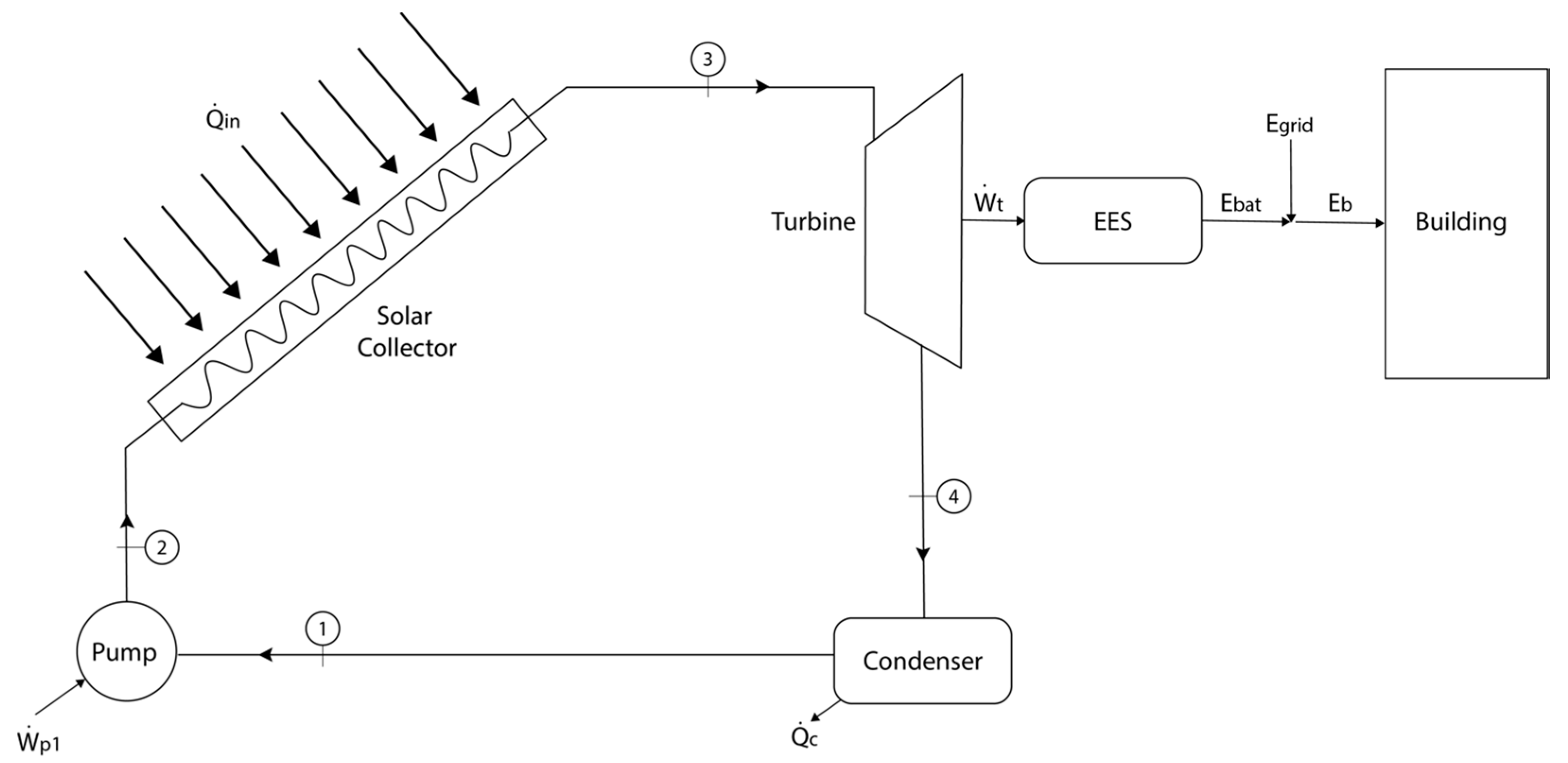
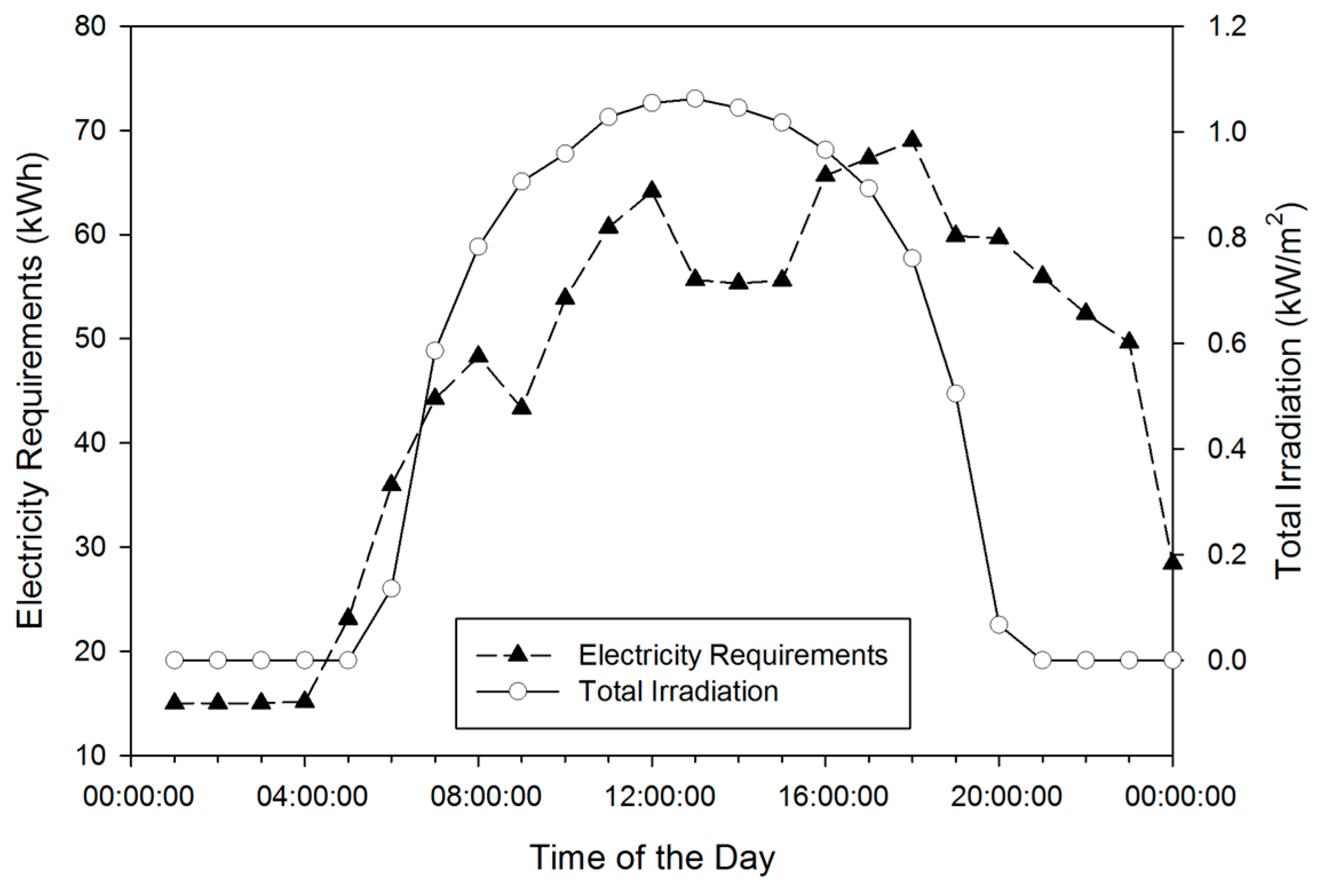
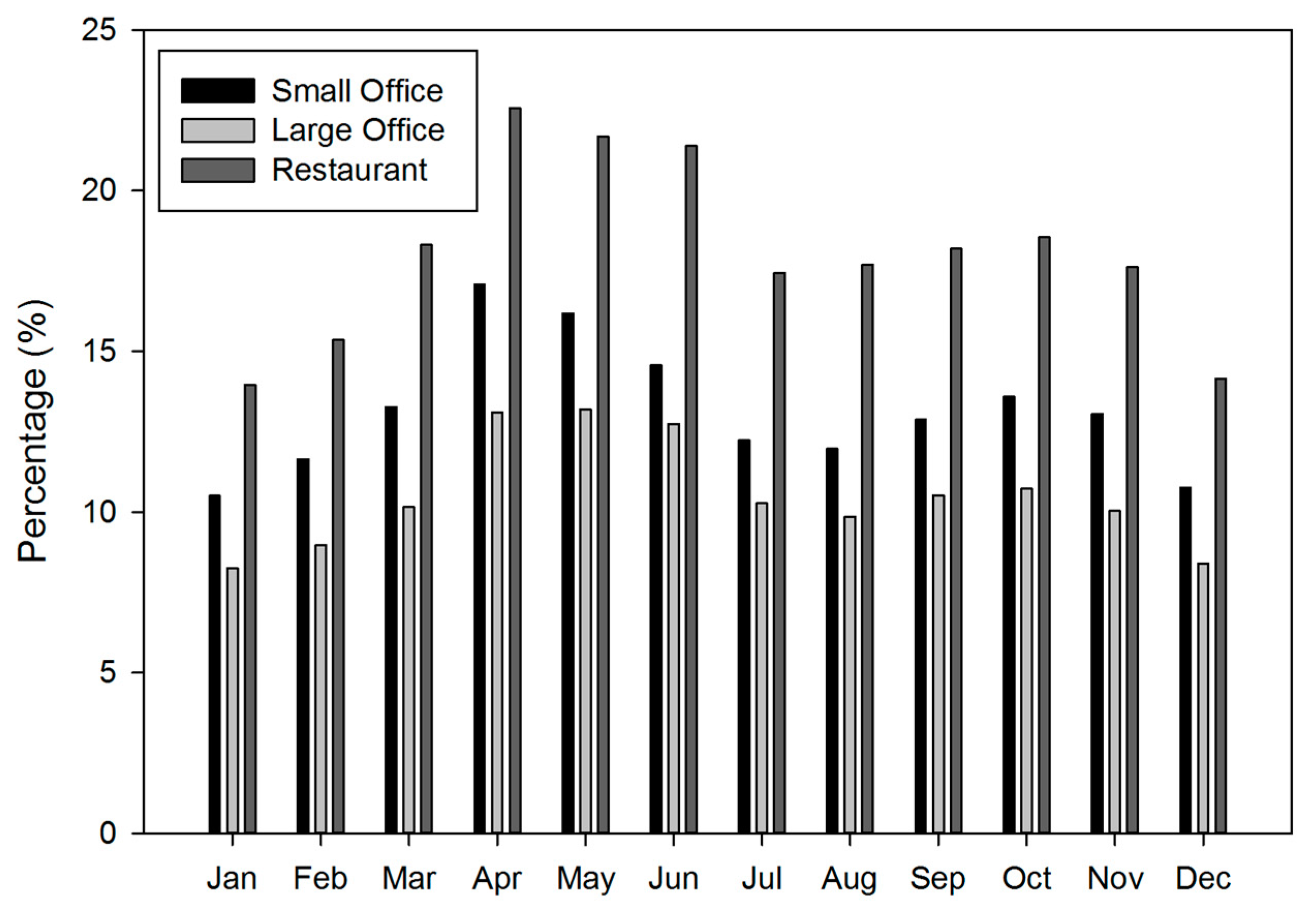
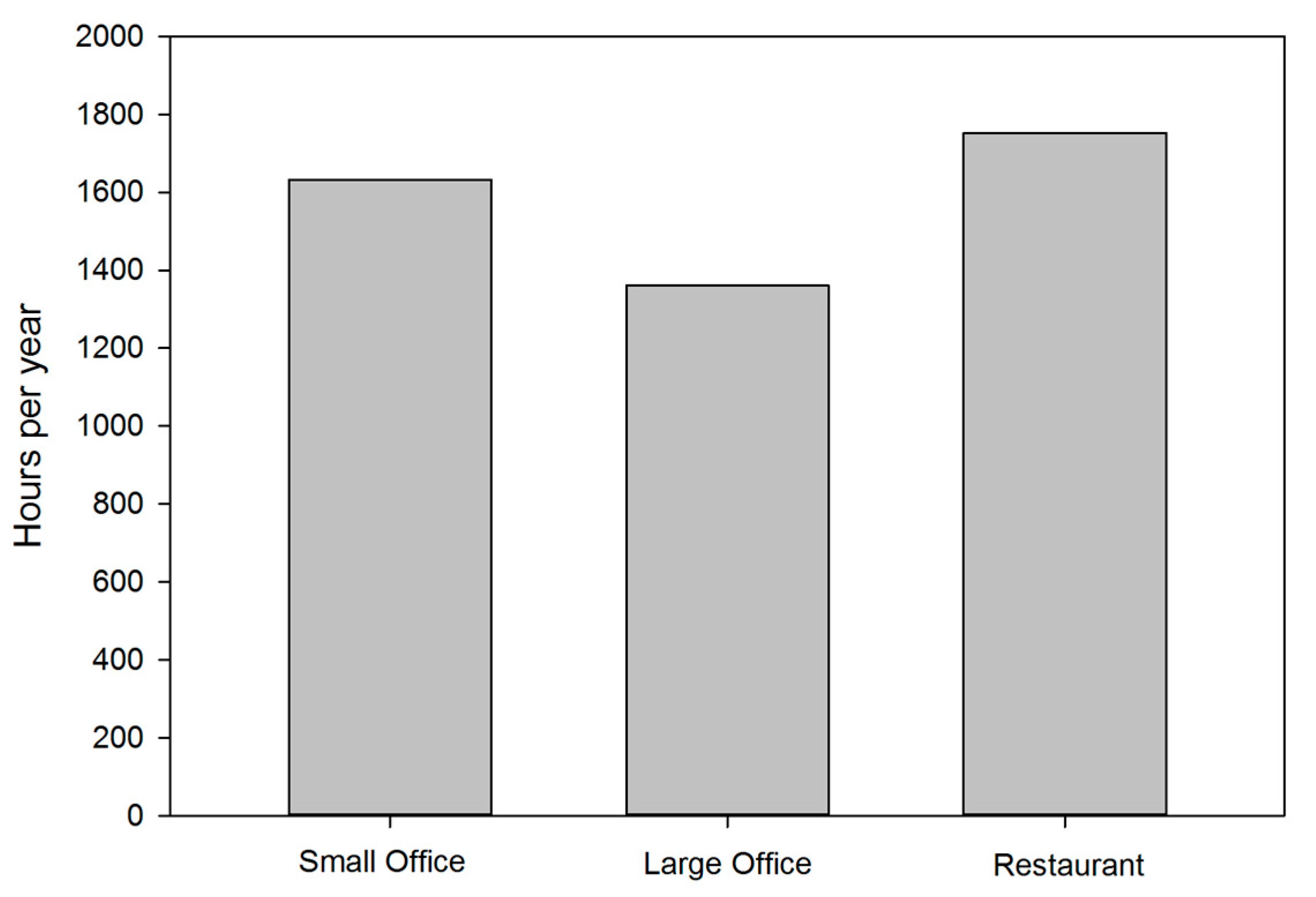
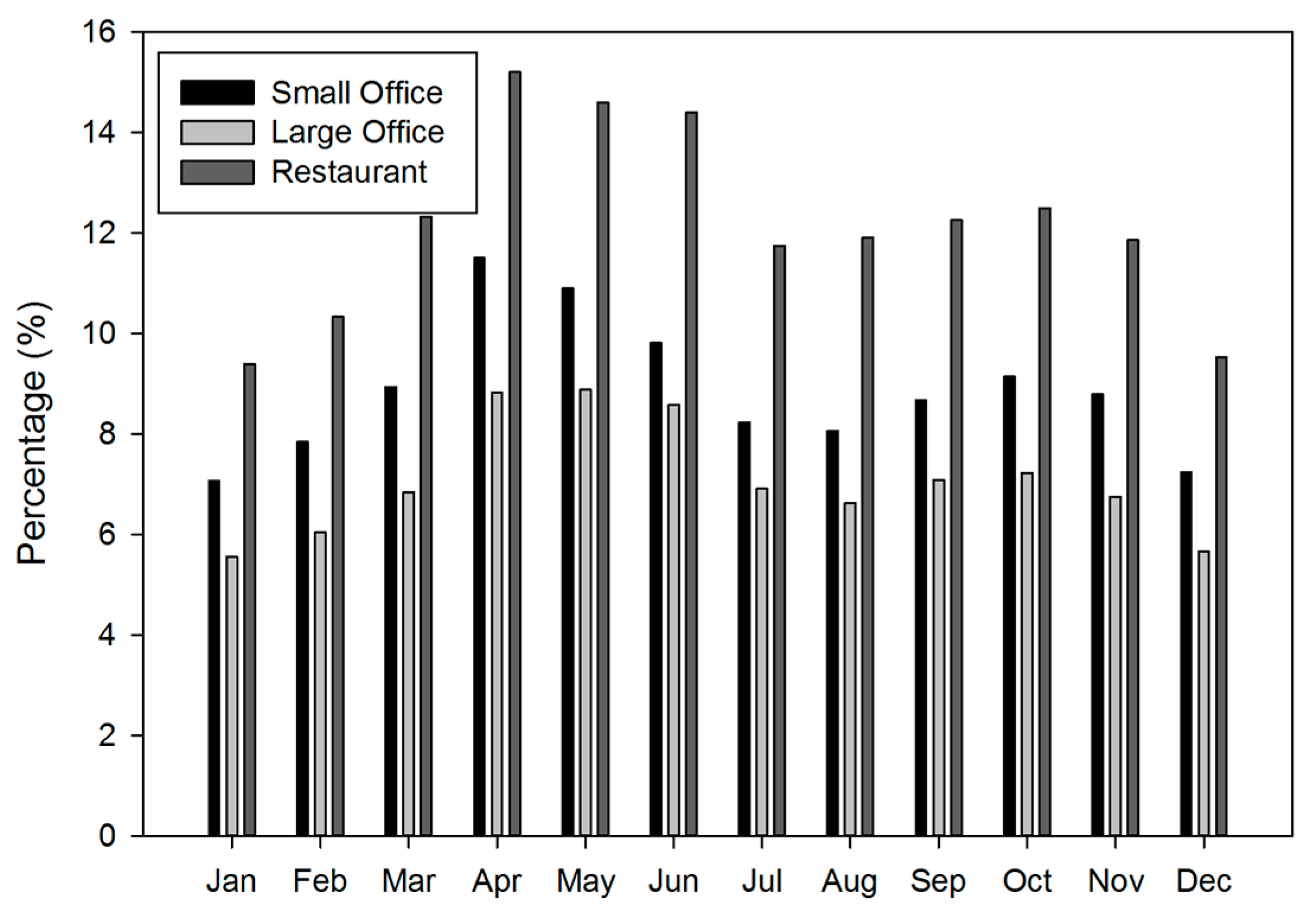
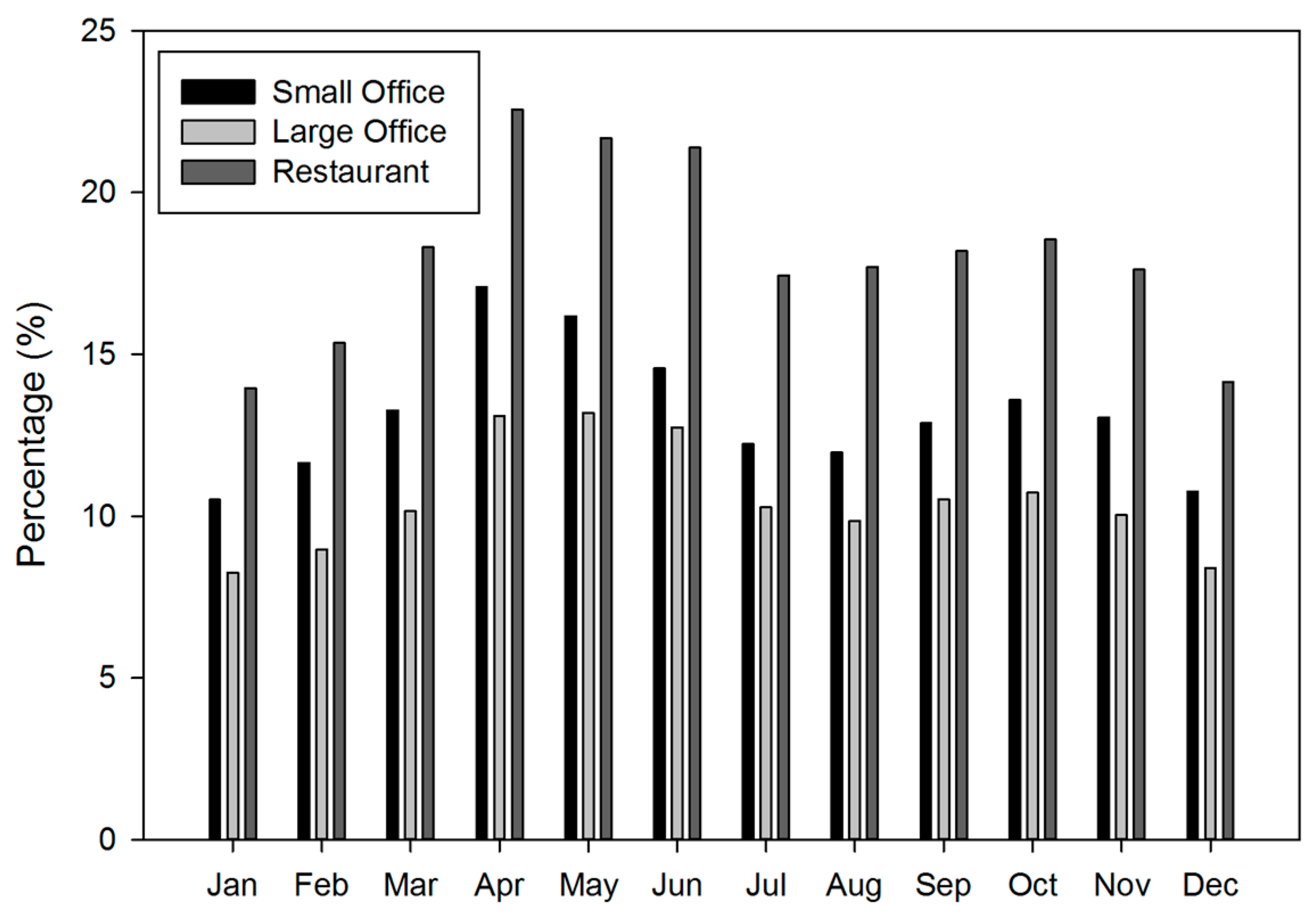
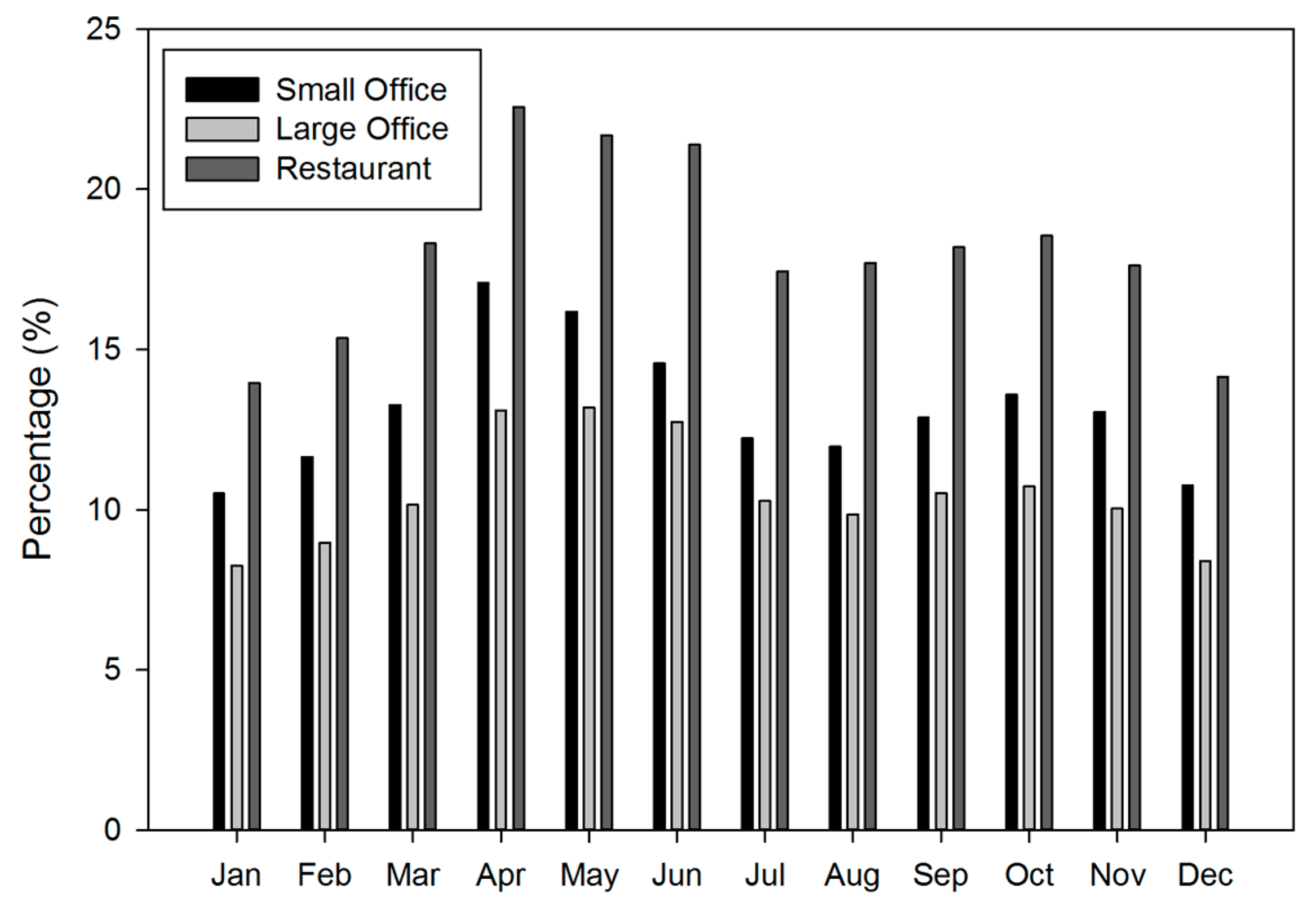
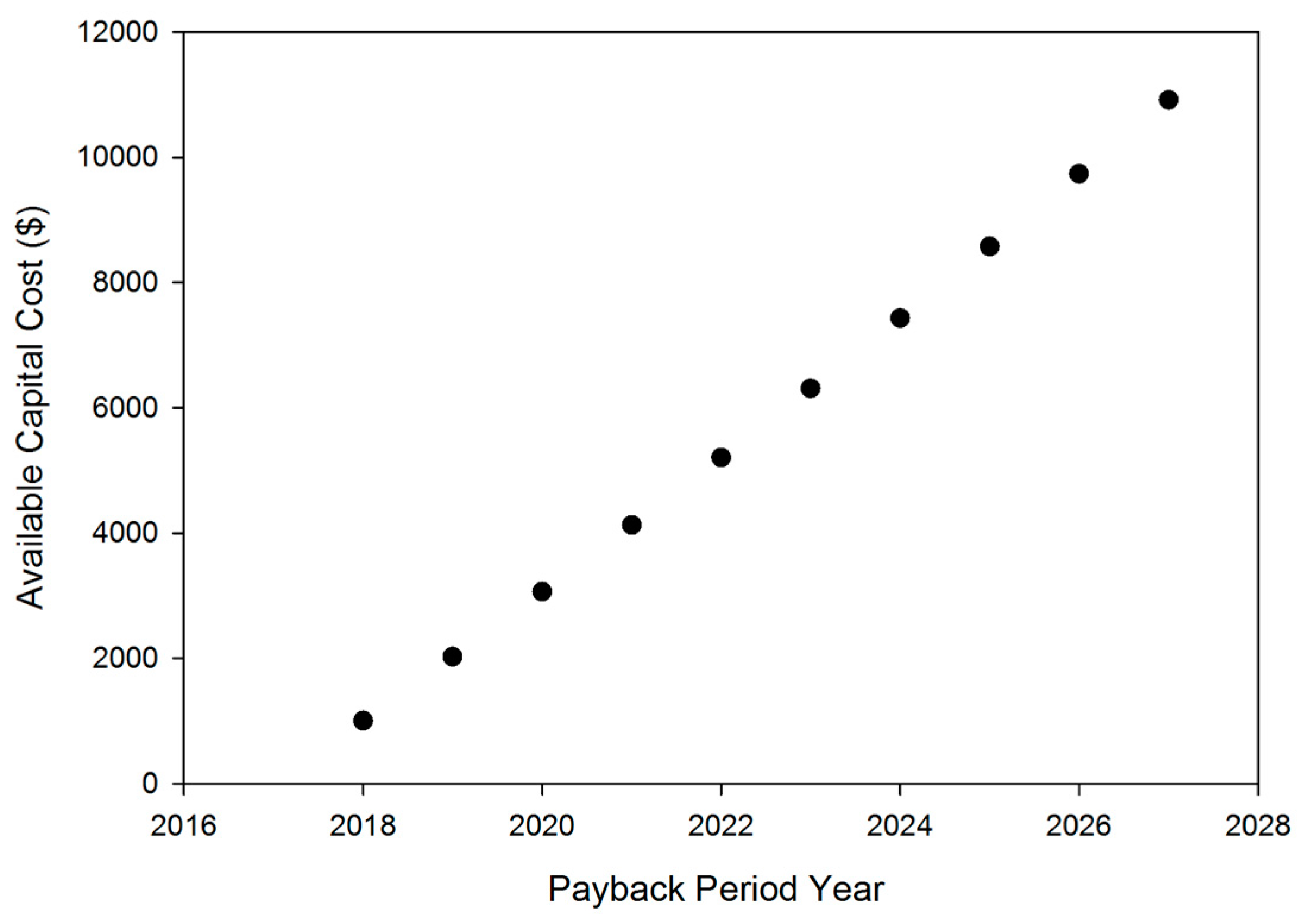
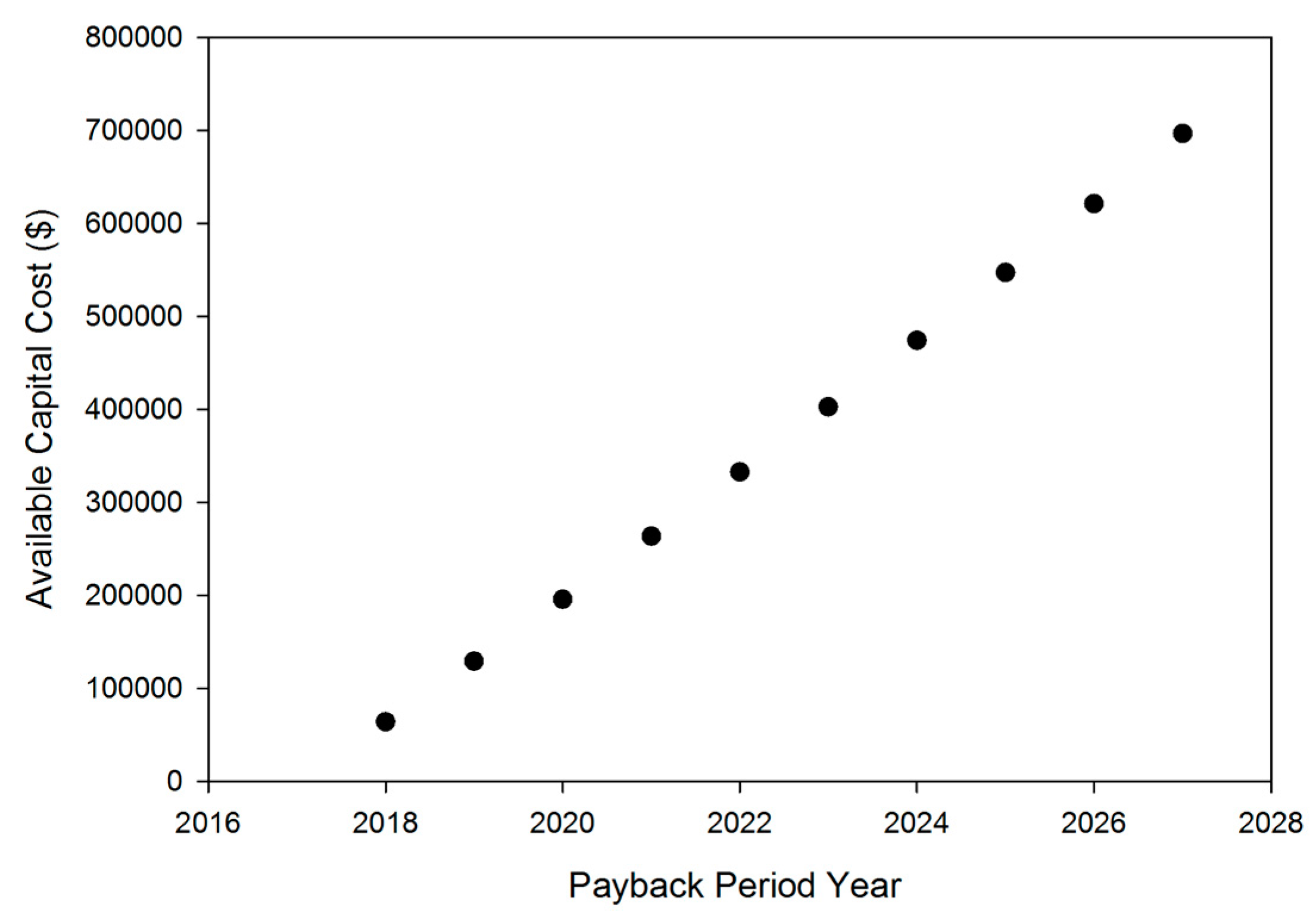
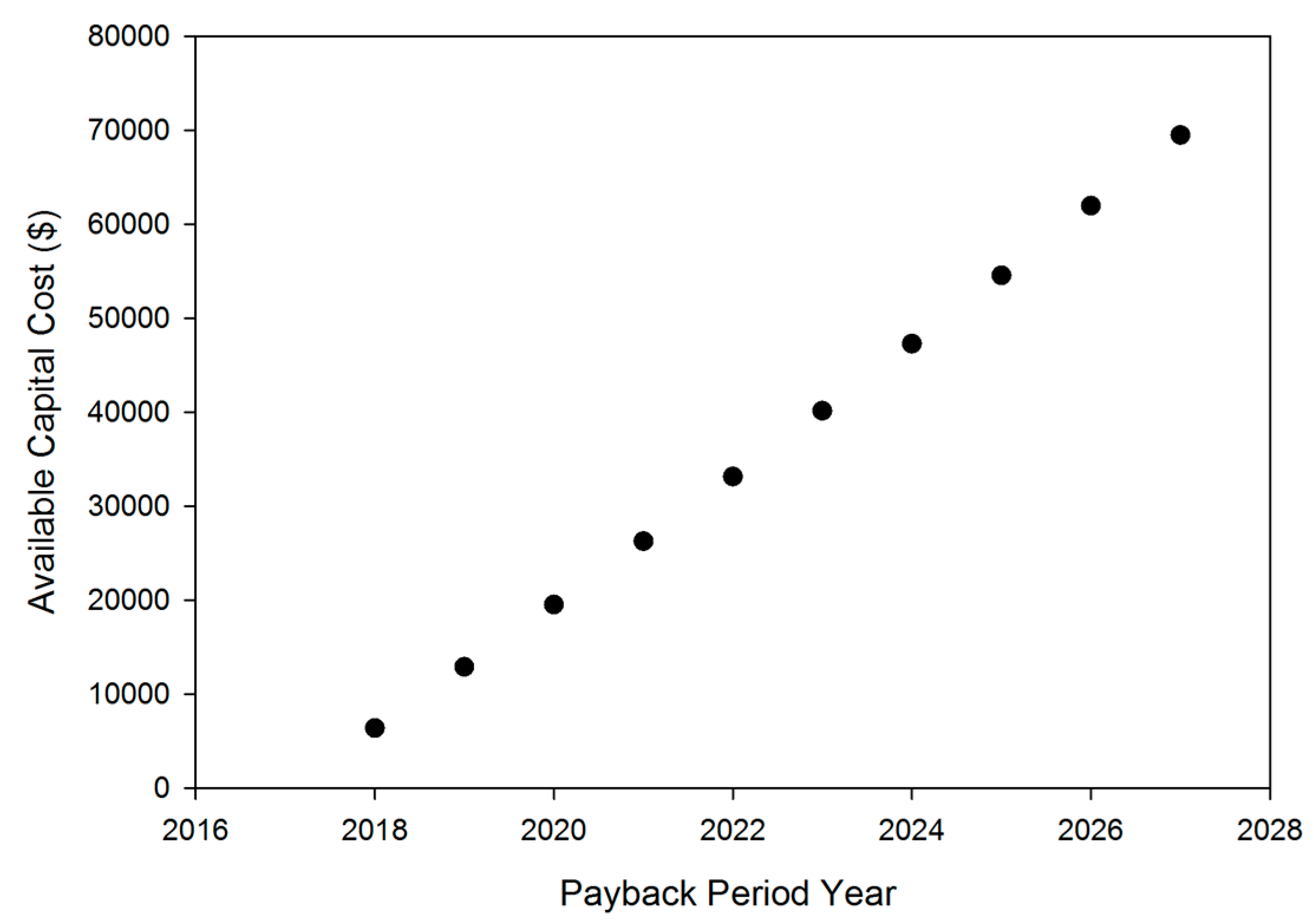
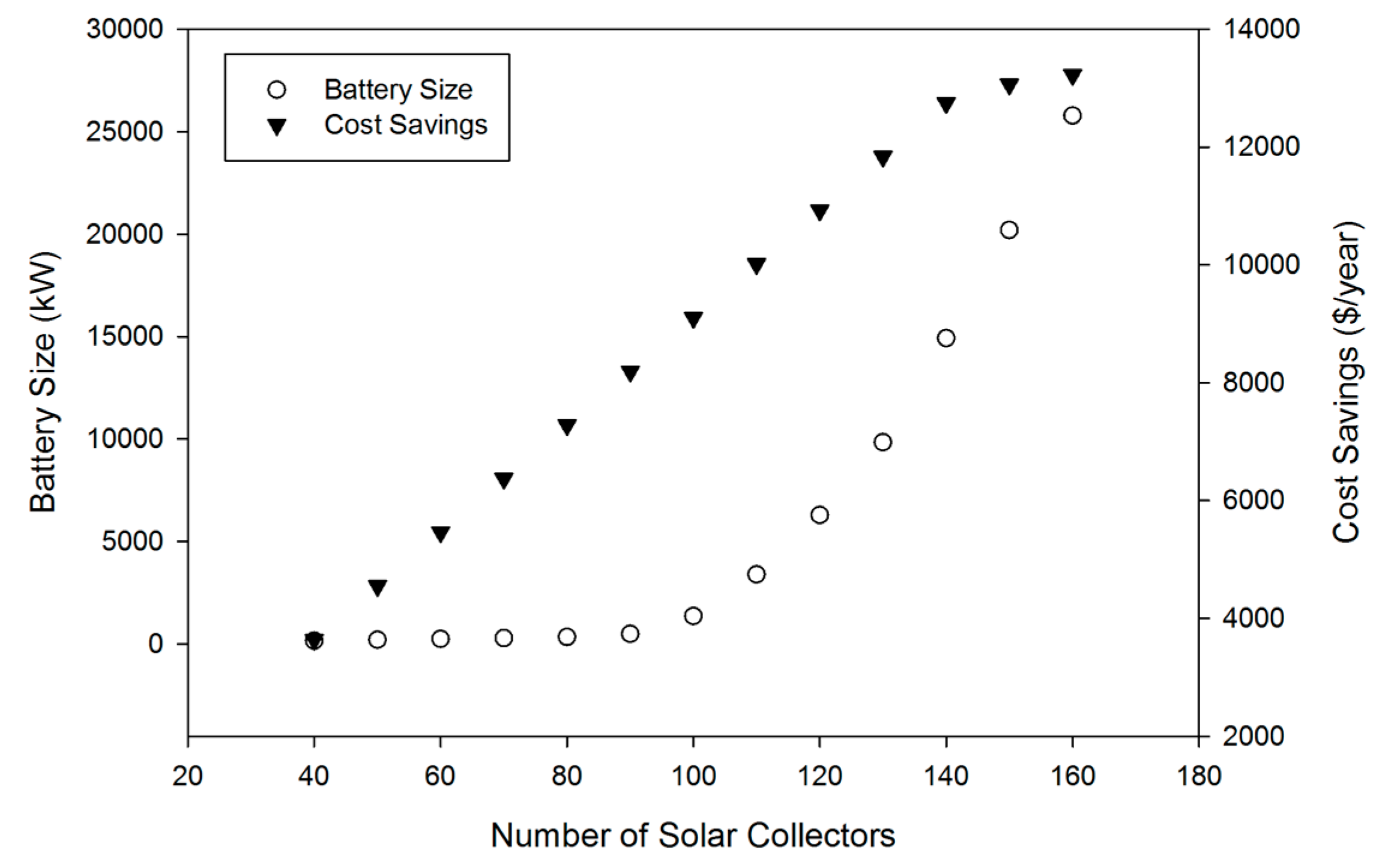
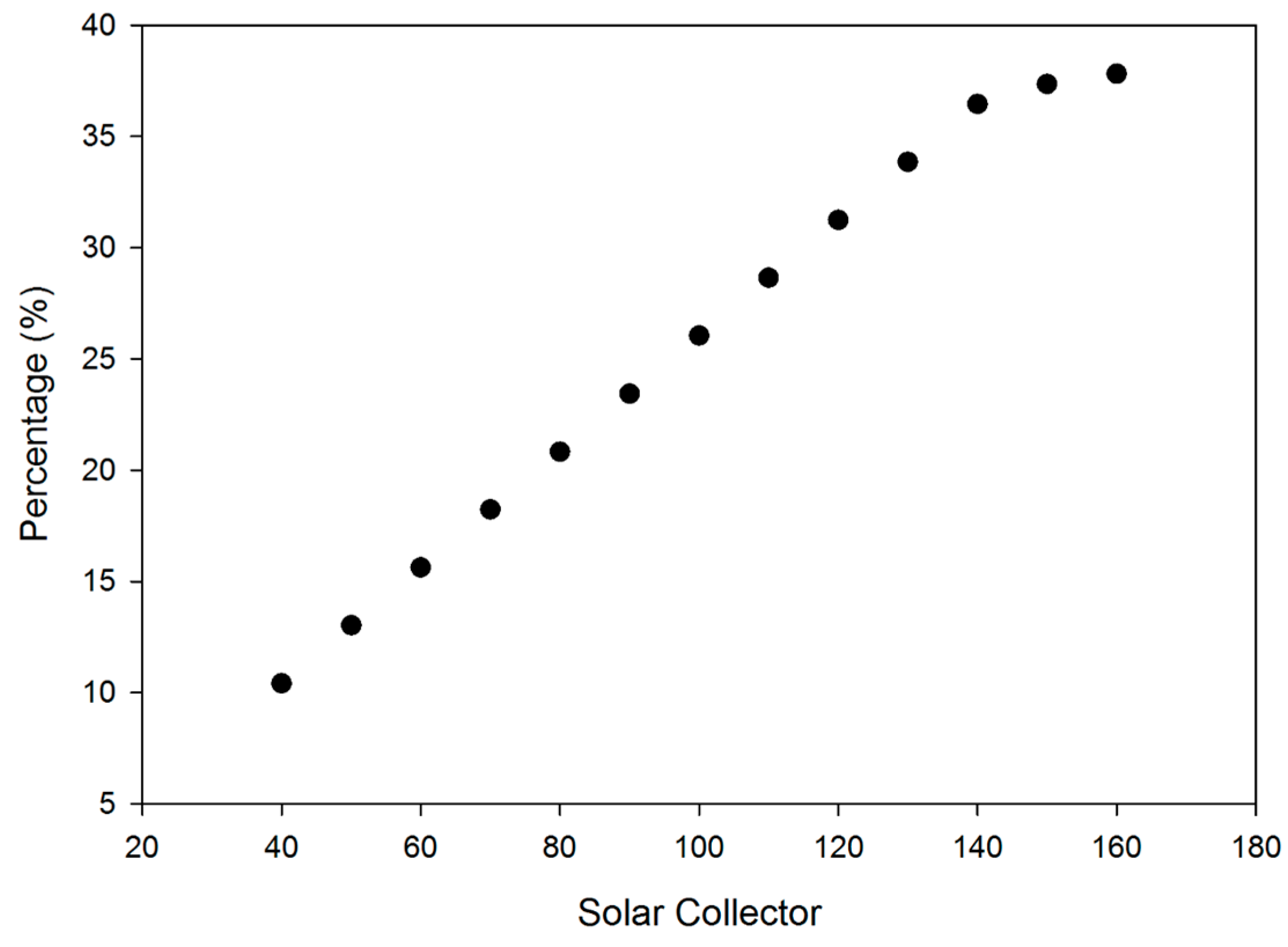
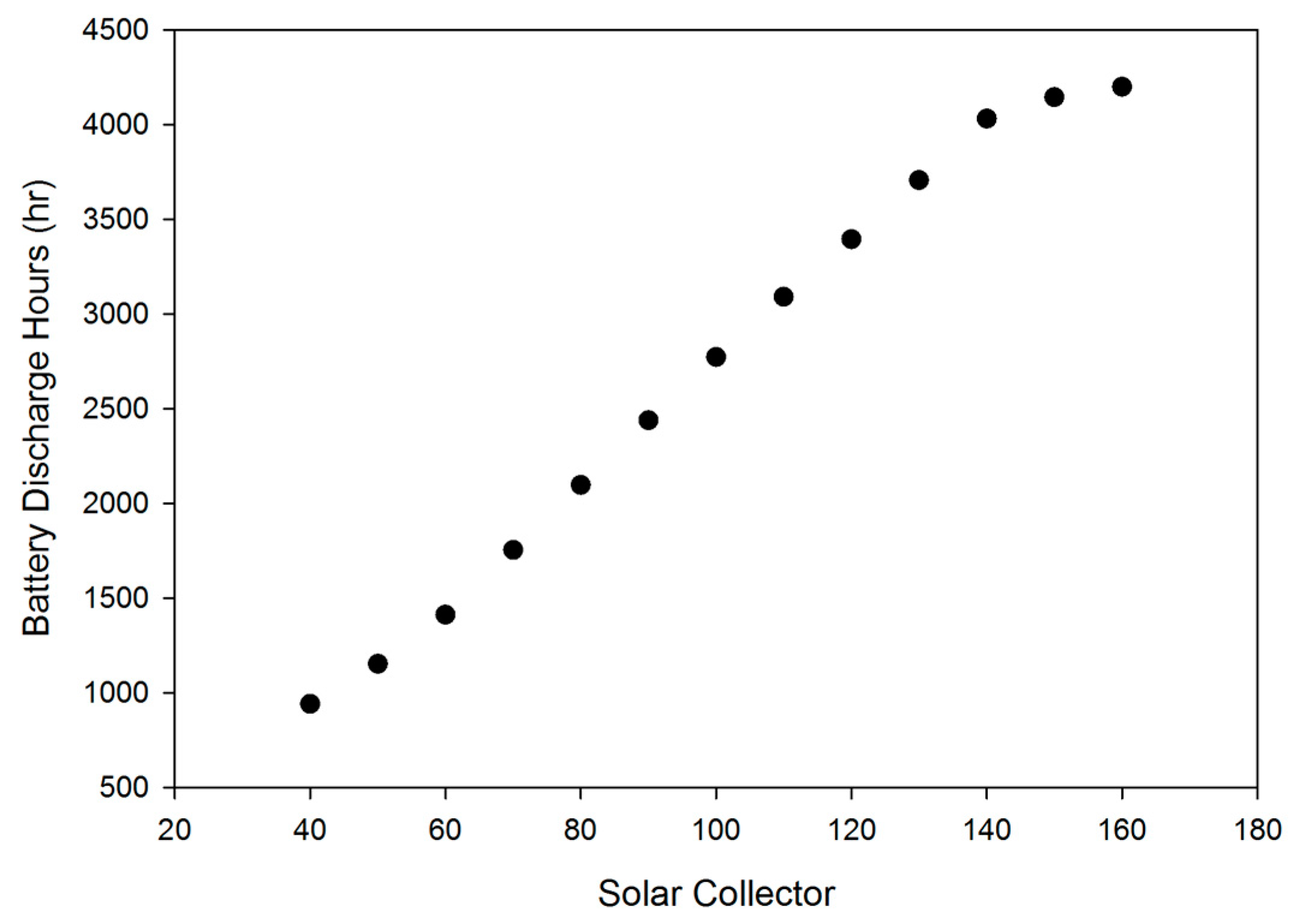
| Building | Floor Area (ft2) | Electricity Requirements (kWh/year) |
|---|---|---|
| Large Office | 498,588 | 6,029,943 |
| Small Office | 5500 | 75,900 |
| Full Service Restaurant | 5500 | 349,634 |
| Parameter | Value |
|---|---|
| Turbine isentropic efficiency, ηt | 0.8 |
| Pump isentropic efficiency, ηp | 0.8 |
| Site-to-source conversion factor for electricity (purchase), ECFPEC [34] (kWh/kWh) | 3.06 |
| Site-to-source conversion factor for electricity (solar), SCFPEC [35] (kWh/kWh) | 1 |
| Conversion factor for purchased electricity for CDE, ECFCDE [37] (kg/kWh) | 0.397 |
| Battery efficiency factor, ξbat [18] | 0.95 |
| Building | No. Solar Collectors | Total Collector Area (ft2) | Battery Size (kWh) | Usable Onsite Energy Generated (kWh/year) | Percentage of Electricity Supplied by ORC-EES |
|---|---|---|---|---|---|
| Large Office | 702 | 27,928 | 2,837 | 639,039 | 10.6% |
| Small Office | 11 | 438 | 45 | 10,013 | 13.2% |
| Full Service Restaurant | 70 | 2785 | 283 | 63,722 | 18.2% |
© 2018 by the authors. Licensee MDPI, Basel, Switzerland. This article is an open access article distributed under the terms and conditions of the Creative Commons Attribution (CC BY) license (http://creativecommons.org/licenses/by/4.0/).
Share and Cite
Spayde, E.; Mago, P.J.; Luck, R. Economic, Energetic, and Environmental Performance of a Solar Powered Organic Rankine Cycle with Electric Energy Storage in Different Commercial Buildings. Energies 2018, 11, 276. https://doi.org/10.3390/en11020276
Spayde E, Mago PJ, Luck R. Economic, Energetic, and Environmental Performance of a Solar Powered Organic Rankine Cycle with Electric Energy Storage in Different Commercial Buildings. Energies. 2018; 11(2):276. https://doi.org/10.3390/en11020276
Chicago/Turabian StyleSpayde, Emily, Pedro J. Mago, and Rogelio Luck. 2018. "Economic, Energetic, and Environmental Performance of a Solar Powered Organic Rankine Cycle with Electric Energy Storage in Different Commercial Buildings" Energies 11, no. 2: 276. https://doi.org/10.3390/en11020276
APA StyleSpayde, E., Mago, P. J., & Luck, R. (2018). Economic, Energetic, and Environmental Performance of a Solar Powered Organic Rankine Cycle with Electric Energy Storage in Different Commercial Buildings. Energies, 11(2), 276. https://doi.org/10.3390/en11020276




